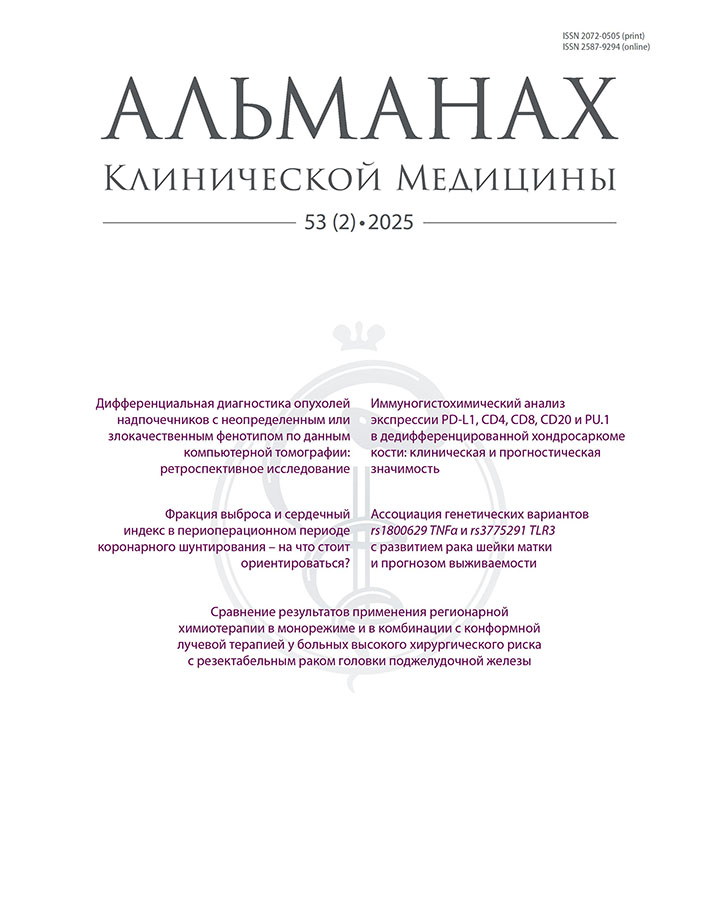Восстановление клинических и инструментальных показателей состояния сердечно-сосудистой системы у пациентов с диффузным токсическим зобом после ликвидации тиреотоксикоза
- Авторы: Алексеева О.А.1, Шапошник И.И.1, Богданов Д.В.1
-
Учреждения:
- ФГБОУ ВО «Южно-Уральский государственный медицинский университет» Минздрава России
- Выпуск: Том 47, № 2 (2019)
- Страницы: 138-148
- Раздел: ОРИГИНАЛЬНЫЕ СТАТЬИ
- URL: https://almclinmed.ru/jour/article/view/1000
- DOI: https://doi.org/10.18786/2072-0505-2019-47-013
- ID: 1000
Цитировать
Полный текст
Аннотация
Актуальность. Изучение состояния сердечно-сосудистой системы у пациентов с широко распространенной патологией щитовидной железы представляет интерес с точки зрения выявления новых факторов риска сердечно-сосудистых событий. В уточнении нуждается вопрос обратимости после лечения изменений, происходящих в сердце и сосудах при тиреотоксикозе.
Цель – оценка степени восстановления и условий обратного развития признаков поражения сердца в отдаленные сроки после ликвидации тиреотоксикоза медикаментозным и хирургическим методом у больных диффузным токсическим зобом (ДТЗ).
Материал и методы. Проведено открытое продольное ретроспективное исследование на базе Областного центра эндокринной хирургии МУЗ ГКБ № 1 г. Челябинска. Обследованы 124 пациента с ДТЗ в анамнезе. Все пациенты на момент обследования имели стойкую клинико-лабораторную ремиссию после отмены тиреостатических препаратов либо были прооперированы по поводу ДТЗ в сроки 1,5–5 лет до исследования и находились в состоянии компенсированного послеоперационного гипотиреоза. В группе пациентов после медикаментозной терапии (n=62) средний возраст составил 39,9±1,31 года (от 19 до 55 лет). Средний возраст пациентов после хирургического лечения ДТЗ (субтотальная резекция) (n=62) был 41,1±1,4 года (от 21 до 56 лет). Сопоставили жалобы, параметры электрокардиографии и эхокардиографии в момент настоящего обследования с аналогичными данными в момент первичного обращения.
Результаты. Жалобы на одышку выявили у 56,5% (35/62), сердцебиение – 54,8% (34/62), кардиалгии – 50% (31/62) пациентов после оперативного лечения (p<0,01) и, соответственно, у 59,7% (37/62), 64,5% (40/62), 56,5% (35/62) пациентов после медикаментозного лечения в отдаленные сроки после ликвидации тиреотоксикоза (p<0,01). У 99% пациентов, имевших артериальную гипертензию (АГ) в дебюте ДТЗ, повышение артериального давления сохранялось. У пациентов после оперативного лечения в 30% (19/62) случаев степень АГ оказалась выше, чем в дебюте ДТЗ. Уменьшение размера левого предсердия и конечно-диастолического размера правого желудочка выявлено у 17 и 24 пациентов соответственно. Все они были прооперированы и не имели АГ. На фоне медикаментозного лечения и у прооперированных пациентов с АГ восстановления размера полостей не выявлено. Изменения сегмента ST и зубца T не имели связи с клиническими симптомами как при первичном обследовании, так и в отдаленные сроки. Все обследуемые пациенты в отдаленные сроки после лечения имели нормальные уровни тиреотропного гормона (ТТГ) и тироксина (Т4), зависимости клинических и инструментальных данных от уровня ТТГ и Т4 не обнаружено. У пациентов, перенесших ДТЗ, были выявлены тахикардия, АГ, диастолическая дисфункция, увеличение индекса массы миокарда левого желудочка.
Заключение. Нарушения сердечно-сосудистой системы сохранялись длительное время после ликвидации ДТЗ. Возникшая на фоне ДТЗ артериальная гипертензия оказывала отрицательное влияние на структурно-функциональное состояние сердца при данном заболевании, независимо от метода лечения. У пациентов, перенесших ДТЗ, мы наблюдали такие предикторы сердечной недостаточности, как тахикардия, АГ, диастолическая дисфункция, увеличение индекса массы миокарда левого желудочка.
Об авторах
О. А. Алексеева
ФГБОУ ВО «Южно-Уральский государственный медицинский университет»Минздрава России
Email: fake@neicon.ru
Алексеева Ольга Александровна – канд. мед. наук, ассистент кафедры пропедевтики внутренних болезней,
454092, г. Челябинск, ул. Воровского, 64
РоссияИ. И. Шапошник
ФГБОУ ВО «Южно-Уральский государственный медицинский университет»Минздрава России
Email: fake@neicon.ru
Шапошник Игорь Иосифович – д-р мед. наук, профессор, заведующий кафедрой пропедевтики внутренних болезней,
454092, г. Челябинск, ул. Воровского, 64
РоссияД. В. Богданов
ФГБОУ ВО «Южно-Уральский государственный медицинский университет»Минздрава России
Автор, ответственный за переписку.
Email: dmitrchel@mail.ru
Богданов Дмитрий Владимирович – д-р мед. наук, доцент, доцент кафедры пропедевтики внутренних болезней,
454007, г. Челябинск, Артиллерийский пер., 2–79
+7 (912) 477 34 37
РоссияСписок литературы
- Дедов ИИ, Мельниченко ГА. Российские клинические рекомендации. Эндокринология. М.: ГЭОТАР-Медиа; 2016. 592 с.
- De Groot L, Abalovich M, Alexander EK, Amino N, Barbour L, Cobin RH, Eastman CJ, Lazarus JH, Luton D, Mandel SJ, Mestman J, Rovet J, Sullivan S. Management of thyroid dysfunction during pregnancy and postpartum: an Endocrine Society clinical practice guideline. J Clin Endocrinol Metab. 2012;97(8): 2543–65. doi: 10.1210/jc.2011-2803.
- Мареев ВЮ, Фомин ИВ, Агеев ФТ, Беграмбекова ЮЛ, Васюк ЮА, Гарганеева АА, Гендлин ГЕ, Глезер МГ, Готье СВ, Довженко ТВ, Кобалава ЖД, Козиолова НА, Коротеев АВ, Мареев ЮВ, Овчинников АГ, Перепеч НБ, Тарловская ЕИ, Чесникова АИ, Шевченко АО, Арутюнов ГП, Беленков ЮН, Галявич АС, Гиляревский СР, Драпкина ОМ, Дупляков ДВ, Лопатин ЮМ, Ситникова МЮ, Скибицкий ВВ, Шляхто ЕВ. Клинические рекомендации ОССН – РКО – РНМОТ. Сердечная недостаточность: хроническая (ХСН) и острая декомпенсированная (ОДСН). Диагностика, профилактика и лечение. Кардиология. 2018;58(6S):8–158. doi: 10.18087/cardio.2475.
- Алексеева ОА. Структурно-функциональные изменения сердечно-сосудистой системы у пациентов после оперативного лечения диффузного токсического зоба. Вестник Южно-Уральского государственного университета. 2010;(24):91–3.
- Chaker L, Korevaar TIM, Rizopoulos D, Collet TH, Völzke H, Hofman A, Rodondi N, Cappola AR, Peeters RP, Franco OH. Defining optimal health range for thyroid function based on the risk of cardiovascular disease. J Clin Endocrinol Metab. 2017;102(8):2853–61. doi: 10.1210/jc.2017-00410.
- Петунина НА. К вопросу о состоянии сердечно-сосудистой системы при нарушении функции щитовидной железы. Международный эндокринологический журнал. 2007;4(10):97–102. [Интернет]. Доступно на: http://www.mif-ua.com/archive/article_print/2895.
- Wu Y, Koenig RJ. Gene regulation by thyroid hormone. Trends Endocrinol Metab. 2000;11(6):207–11. doi: 10.1016/S1043-2760(00)00263-0.
- Vargas-Uricoechea H, Bonelo-Perdomo A, Sierra-Torres CH. Effects of thyroid hormones on the heart. Clin Investig Arterioscler. 2014;26(6): 296–309. doi: 10.1016/j.arteri.2014.07.003.
- Сафарова ЛШ. Отдаленные результаты хирургического лечения диффузного токсического зоба. Вестник хирургии Казахстана. 2016;(2):50–4.
- Олифирова ОС, Трынов НН. Послеоперационный гипотиреоз. Вестник хирургии имени И.И. Грекова. 2015;174(1):20–2. doi: 10.24884/0042-4625-2015-174-1-20-22.
- Anakwue RC, Onwubere BJ, Ikeh V, Anisiuba B, Ike S, Anakwue AM. Echocardiographic assessment of left ventricular function in thyrotoxicosis and implications for the therapeutics of thyrotoxic cardiac disease. Ther Clin Risk Manag. 2015;11:189–200. doi: 10.2147/TCRM. S68752.
Дополнительные файлы








